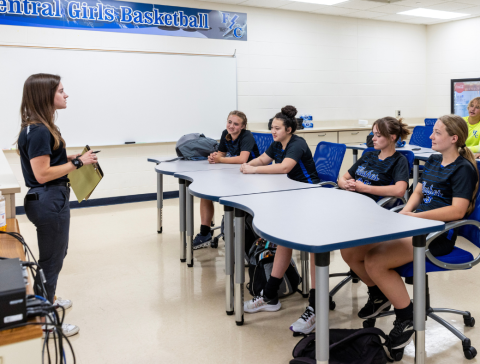I Want to Be an Athletic Trainer
Your AT Journey Starts Here.
You have a lot of questions about what it takes to become an athletic trainer, and we've got answers. Think of us as your guide into the athletic training universe. If you think you're interested in educating and treating patients and athletes, reducing the risk of injury on the field or at work, and helping them recover and improve their performance, you're in the right place. Watch videos, bookmark pages and click around, because your athletic training journey starts right here. Welcome to the AT universe.
Your AT Road Map
Step 1
Get a Bachelor's Degree
Major in exercise science, kinesiology or other health related field. Then apply to an accredited Master's of Athletic Training program.
Step 2
Get a Master's Degree in Athletic
Training
Apply to an accredited athletic training education program. This can be the same college where you're getting your bachelor's degree, or you can apply to several programs with one application, linked below.
Step 3
Get Certified
Take and pass the BOC exam. Once you pass the certification exam, check with your state licensing board for regulations.
Step 1
Get a Bachelor's Degree
Major in exercise science, kinesiology or other health related field. Search for accredited Master's of Athletic Training program if you're not in an AT track.
Step 2
Get a Master's Degree in Athletic Training
Apply to an accredited athletic training education program. You can apply through the Athletic Trainer Centralized Application System here.
Step 3
Get Certified
Pass your Board of Certification for Athletic Trainer exam. Once you pass, your state may require you to obtain licensure to practice athletic training.
Becoming an Athletic Trainer
If you like helping people, sports medicine and science, becoming an athletic trainer (AT) just might be the right career choice for you.
Athletic trainers are not personal trainers or physical therapists. They work with their patients before they get hurt, during their recovery and after they get well to improve performance.
ATs work with all different kinds of people in different places. Did you know that ATs work with firefighters and policemen? Or performing artists? ATs have worked with astronauts, rodeo competitors and even distribution-center workers like those at Amazon. Many students like you know that many ATs work in high schools, middle schools, colleges and universities, professional sports teams and recreational leagues, as well as in hospitals and clinics.
ATs provide an all-encompassing medical approach to health care. As a part of the health care team, ATs provide primary care, injury and illness prevention, wellness promotion and education, emergent care, examination and clinical diagnosis, therapeutic intervention and rehabilitation of injuries and medical conditions.
Choosing your focus will come later in your AT journey. The path you follow is up to you. Remember, we're just the guide. You make the choice. AT4Me.
What Classes Should I Take in High School?
In order to build a solid foundation for college, you will need to take science and math courses. These can include:
- Biology
- Chemistry
- Physics
- Algebra
- Sports medicine
- CPR/AED
The Athletic Training Universe: The Past, Present and Future
Did you know that athletic training began in the late 1800s, before iPhones, computers and even sports medicine existed? Today, athletic trainers work in a variety of settings and are in high demand. Learn more about the origins of athletic training. View profiles of the first athletic trainers, current athletic trainers and what the future may hold for you as an athletic trainer.
Education Requirements
Learn what the education requirements are to become an athletic trainer.
5 Signs You Were Born to be an AT
How do you know you've got what it takes to become an athletic trainer? Read our article.
Who Are ATs?
Who are athletic trainers? What do they do? Athletic trainers provide primary care, injury and illness prevention, wellness promotion and education, emergent care, examination and clinical diagnosis, therapeutic intervention and rehabilitation of injuries and medical conditions.
Where Do ATs work?
Most people have seen an athletic trainer run across the field to assess an injury during a high school, college or professional sports game. But athletic trainers work with a variety of patient populations in numerous environments, from clinics and hospitals to performing arts and even aeronautics.
Resources and Opportunities
From networking to NATA Foundation Scholarships, find resources to help realize your dream of becoming an athletic trainer. Find information on NATA Student Membership benefits, NATA Mentorship Program, NATA Career Center as well as our AT Terminology list and much, much more.


